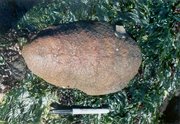Chiton
|
|
Chitons, also called polyplacophorans ,Chitonidae and rarely polyplacophores, are 860 species of molluscs of the Class Polyplacophora. They creep along slowly on their muscular feet. Most extant species are found in the intertidal zone, on or in rocks, but some species have been found as deep as 4000 meters. Individual plates are sometimes called "butterfly shells."
| Contents [hide] |
Structure
The calcareous armour shell that chitons carry dorsally are protective, are made wholly of aragonite, and are variously colored, patterned, smooth or sculptured. The shell is divided into eight articulating plates (also called valves) embedded in the tough muscular girdle that surrounds the chiton's body. This arrangement allows chitons to roll into a protective ball when dislodged and to cling tightly to even irregular surfaces. The girdle is often ornamented with spicules, bristles, hairy tufts, or snake-like scales. The majority of the body is a snail-like foot, but no head or other soft-parts beyond the girdle are visible from the dorsal side. Between the body and the girdle, there is a mantle cavity, connected to the outside by two water channels. The one on the side is the incurrent water channel. The one attached to the anus is the excurrent water channel. [1] (http://www.animalnetwork.com/fish2/aqfm/1999/aug/art0801/wbfig1.jpg) The gills hang down into the mantle cavity, usually near the anus. An anterior head has a mouth containing a tongue-like structure called a radula, which has numerous rows of usually 17 teeth each. The teeth are coated with magnetite, a ferrous mineral that hardens the teeth. The radula is used to scrape microscopic algae off the substratum.
Name
Black Chiton (Katharina tunicata) on a stone with a seastar
Its English name originates from a Greek word chitōn, which means "tunic" and is also the source word of the substance chitin. Its Greek-derived name Polyplacophoran comes from the words poly- (many), plako- (tablet), and -phoros (bearing). Chitons were first studied by Linnaeus in 1758. Since his description of the first four species, chitons have been variously classified. They were called Cyclobranchians ("round arm") in the early 19th century, and then grouped with the aplacophorans in the subphylum Amphineura in 1876. The Class Polyplacophora was named by J. E. Gray in 1821.
Activities
Chitons eat algae, bryozoans, diatoms and sometimes bacteria by scraping the rocky substrate with their well-developed radula. Some species have an enlarged anterior girdle by which they feed on other small invertebrates, such as shrimp and possibly even small fish, by holding the girdle up off the surface and then clamping down on the unsuspecting, shelter-seeking prey. Some chitons exhibit homing behavior, returning to the same spot during the day and coming out at night to feed.
Predators include seagulls, seastars, crabs, fishes and sea anemones.
Miscellaneous
The largest chiton (up to 30 cm in length) is the pink gumboot chiton of the Pacific Northwest. [2] (http://www.alaska.net/~scubaguy/images/gumbootchiton.jpg)


